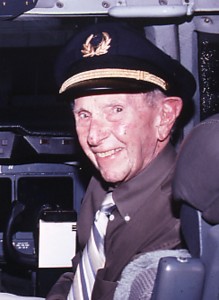By Bob Shane

Released initially in 1954, “The High and the Mighty” has been meticulously restored and re-mastered.
Released in 1954, the aviation movie classic, “The High and the Mighty,” hasn’t been seen for decades. People, particularly John Wayne fans, weren’t sure if they would ever have the opportunity to view the movie again. Having been out of circulation for so long, there were rumors of damaged film and reels being lost to wear and color fading. The motion picture had never been released on video or DVD.
Thanks to Paramount Home Entertainment and Batjac Productions, “Whistling” Dan Roman (John Wayne) and Trans-Orient Pacific Airlines flight 420 are once again winging their way across the Pacific from Honolulu to San Francisco. Effective August 2, “The High and the Mighty” became available in a special two-disc collector’s edition. Meticulously restored and re-mastered, the film’s technical quality has been elevated to an impeccable standard worthy of a movie classic.
Pilot Bill Keating, who did all of the actual DC-4 flying in the movie, attended the re-screening of “The High and the Mighty” at Paramount Theater, Paramount Studios in Hollywood, on July 12. Keating has had a prolific career as an aviator, one that spans almost 50 years and over 30,000 hours of flying. After the war, he was the director of flight operations for Transocean Air Lines. There he met Ernest K. Gann when he got him a job as a copilot for the airline.
They flew together and became good friends. It was while Gann was working at Transocean that he wrote his novel, “The High and the Mighty.”
The actual flying scenes for the movie were filmed during the third week of November 1953, using a DC-4 borrowed from Transocean Air Lines and piloted by Keating. The DC-4 was painted in the fictitious airline colors of Trans-Orient Pacific Airlines (TOPAC). The filming was primarily done at both San Francisco and Oakland airports, with some ground scenes shot at Burbank.
The most memorable experience for Keating came during the filming of the simulated emergency night landing on 28R at San Francisco. The approach lights were turned up to their maximum brightness. Keating followed the localizer and glide slope on his first approach. During the taxi back, the director, William Wellman, talked to Keating on the radio, reportedly saying, “Bill, that was OK, but we need you lower.”
Keating took off and shot a second approach, this time below the glidescope.
“The lights were bright, causing the crew to squint,” he recalls.
Again, Wellman reportedly said, “That was good but could you do it a little lower.” On the third landing, as the DC-4 descended over the approach lights, it got too low, taking out some of the lights with the nose gear. Keating’s wife, who was with the director, asked Wellman what he would have done if Keating had crashed. Wellman reportedly responded that he would have some great footage for the end of another movie!
Ernest Gann, a pilot and adventurer, believed that a writer should write about the things that he knew best, and Gann knew flying! The book was in part based on his experiences while flying for Transocean Air Lines. He not only authored the book, but also wrote the screenplay and was a technical advisor during the filming. When you add a director of the caliber of William Wellman, the stage is pretty well set for having a cinematic product that very closely follows the book. Gann wrote nine novels, which subsequently were made into movies.

Captain Bill Keating did all the actual DC-4 flying during the filming of “The High and the Mighty.”
“The High and the Mighty” isn’t only a classic John Wayne flick; it’s also the definitive pioneering effort in the evolution of the modern disaster film. Dan Roman (Wayne) plays a veteran airline pilot who started flying way back in 1917. He loses his captain’s stripes as a result of a crash that claims the lives of all of the passengers, including his wife and child. Now flying as a copilot, he boards a DC-4 in Honolulu, its destination being San Francisco. Just as the airliner passes the point of no return, disaster strikes, resulting in the loss of an engine and a fuel leak that makes it doubtful that the aircraft will reach its destination. The drama unfolds at 9,000 feet, where in addition to the emergency, Roman must deal with ghosts from his past, a captain who loses his nerve, and a cabin full of terrified passengers.
“The High and the Mighty” is a story about people—people from different walks of life that have been thrust together within the confines of an airliner cabin to share an uncertain fate. Gann expertly provides an incisive look into the lives of each passenger and crewmember, revealing both the public and private side of each character. With the combination of Gann’s screenplay and a superb cast including Claire Trevor, Laraine Day, Robert Stack, Jan Sterling, Phil Harris, Robert Newton and more, it’s no wonder that the film was nominated for five Academy Awards, receiving an Oscar for best musical score.
“The High and the Mighty” provides us with a look at commercial flying in the fifties, giving the viewer insight into the fashion standards, attitudes, social customs and level of technological development during that era. This was a time in history when airlines were still trying to convince the public that air travel was safe. You can call it a coincidence, or deja vu, but the actual Transocean DC-4 used in the making of the movie, after reporting an engine fire, crashed into the Pacific, 700 miles west of San Francisco. All nine people on board lost their lives and the aircraft was never recovered. The year was 1964, 10 years after the movie was released.











